Amazon: A super popular eCommerce platform, ranking as the third-largest search engine and having the most customers, worldwide.
But interestingly, big businesses and influencers tend to prefer Shopify for their stores.
Now, the question is: Which one should you pick, Shopify or Amazon?
The decision is not that easy and depends on various factors. Many people make the wrong choices when deciding between Amazon vs Shopify.
That’s why we need to dig into this topic a bit more.
Amazon vs Shopify: Overview
The main difference between Amazon and Shopify lies in their structure.
Amazon functions as a huge marketplace.
For example, if you sell scented candles when searched, it shows your product along with the products of other sellers.
Customers can then compare various options based on ratings, reviews, and prices.
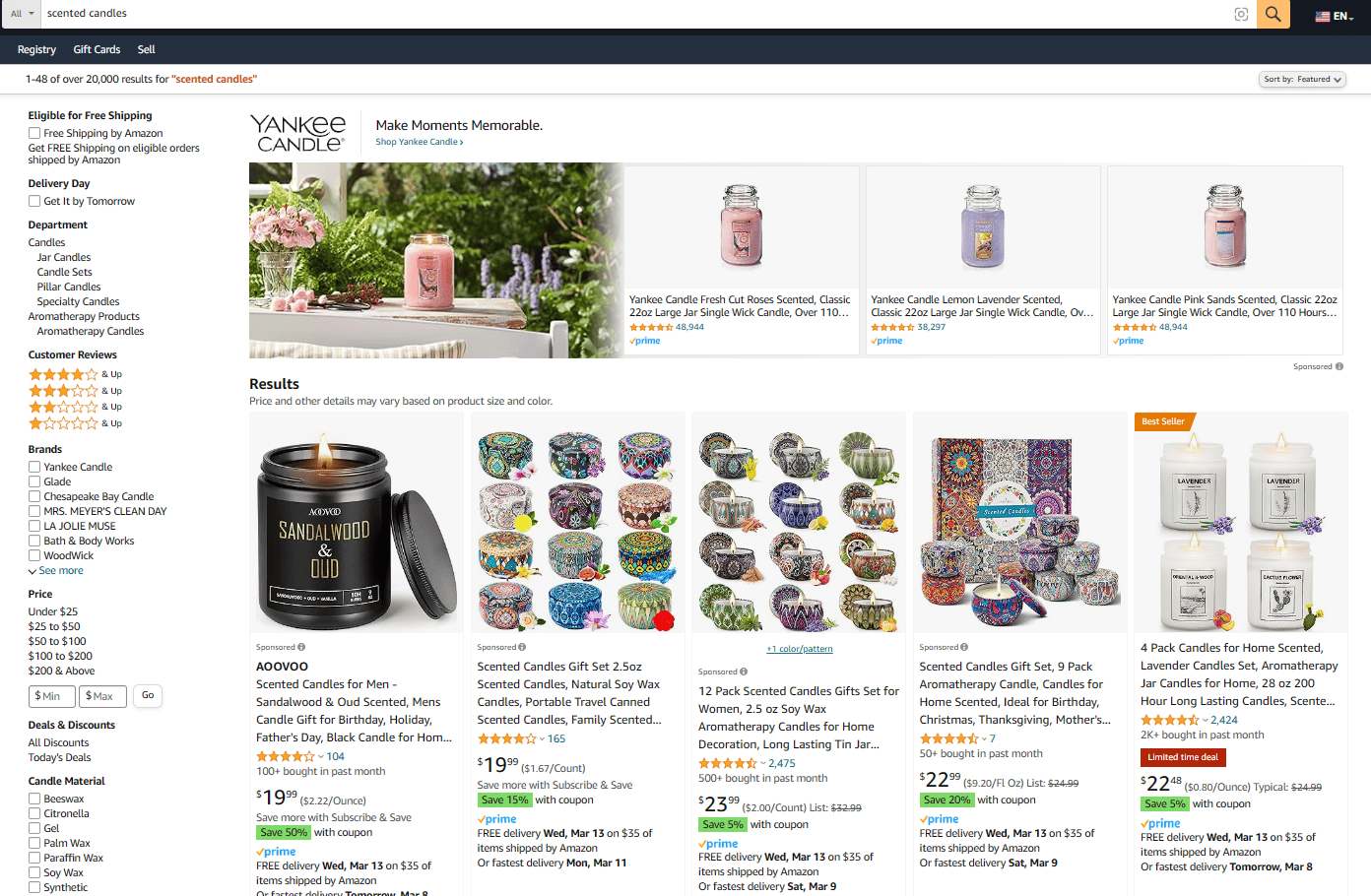
However, you have limited control over the appearance and operation of the website. You are also bound to follow Amazon’s terms and policies.
On the other hand, Shopify gives you your own standalone store. You have full control over your store.
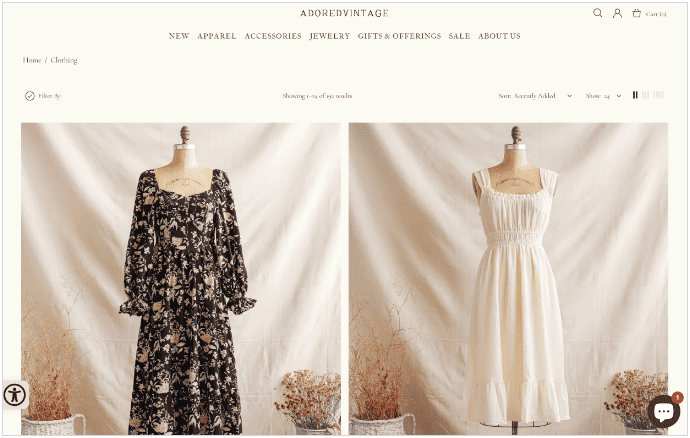
It also offers complete customization to suit your preferences. But to make it a well-known store, you need to have a good understanding of Shopify’s marketing strategies first.
In Shopify, you set the rules. Your customers visit your store exclusively for your product.
Amazon vs Shopify: Pros & Cons
The main question remains: which one should you choose for an e-commerce store, Amazon or Shopify?
Let’s analyze the pros and cons of each one to make an informed decision.
Pros and Cons of Amazon
Amazon has high sales potential, but everything can go sideways with negative ratings.
So before starting selling on Amazon, let’s take a closer look at both the positives and negatives of this platform.
Pros
- Free two-day shipping encourages more purchases and boosts sales
- Amazon has over 300 million customers worldwide, giving sellers access to diverse markets
- FBA Services handles shipping and returns, freeing up sellers’ time
- Amazon’s reputation boosts conversion rates for sellers
- Amazon offers customer service support for both buyers and sellers
Cons
- Platform fees add up with account, selling, and FBA fees
- Limited branding options and basic page layout on Amazon
- Intense competition due to many sellers makes it hard to stand out
- Amazon controls customer data, limiting direct relationships
- Less control over customer experience compared to Shopify
Now let’s discuss the pros and cons of Shopify.
Pros and Cons of Shopify
Shopify provides hosting, security, and payment processing solutions to your store. But it has a steep learning curve.
Pros
- Customize your Shopify store easily.
- Control your branding, customer experience, and data.
- Affordable plans start at $29/month.
- Direct access to customer data for better relationships.
- Support for multiple payment gateways.
Cons
- 2% transaction fee (except for Shopify Payments).
- Need to invest in marketing for traffic.
- Handling inventory, shipping, and fulfillment is your responsibility.
- Time and effort required for site optimization for search engines.
Still confused? Don’t worry we got you covered.
How to choose between Shopify or Amazon?
“The key to making decisions is clarity. You must know where you’re going, and what you’re willing to sacrifice to get there.” – Roy T. Bennett.
So, to give you more clarity, here are a few key factors that will help you choose between selling on Shopify vs Amazon:
Product Type
What kinds of products are you selling? If it’s primarily handmade, custom, or private-label goods, Shopify could be a better option.
Their platform is very customizable and great for showcasing lifestyle imagery. Amazon works well for products with more mainstream appeal and lower prices.
Existing brand
Are you an established brand looking to showcase online?
Shopify gives you complete control over the design and branding of your store.
This differs from Amazon, where products become lost in a sea of items without much chance to distinguish yours from theirs.
However, having a large audience is great as it could help new brands get the exposure they need.
Fees and pricing
Amazon charges higher fees but also has an enormous customer base.
In contrast, Shopify’s fees are lower, but it comes with no customer base.
Amazon’s pricing structure includes an individual plan ($0.99 per item sold) and a professional plan ($39.99/month). Then, there are variable fees, referral fees, and FBA fees.
In the case of Shopify, it has three plans –
- Basic Shopify ($29/month)
- Shopify ($79/month)
- Advanced Shopify ($299/month)
Also, a transaction fee ranges between (0.5%- 2%).
Fulfillment
Shopify doesn’t offer any fulfillment. It would help if you outsourced fulfillment. Amazon’s FBA program is a convenient option.
They handle picking, packing, and shipping for you. You’ll need to consider the additional fees Amazon charges for FBA.
In the end, you need to evaluate your priorities and business goals. Do you value control, customization overreach, and convenience (or vice versa)?
The answer is whether you want to build your independent brand or leverage the power of Amazon’s platform.
Amazon vs Shopify: Quick Comparison
| Aspects | Amazon | Shopify |
|---|---|---|
| Store Ownership | No ownership | You own your store |
| Marketing Cost | Lower upfront cost (marketplace traffic) | Requires marketing effort (build traffic) |
| Brand Recognition | Already trusted brand | Build your brand from scratch |
| Customer Service | Handled by Amazon (mostly) | Manage customer service yourself |
| Fulfillment | Optional FBA (Fulfillment by Amazon) | Manage fulfillment yourself (or 3rd party) |
| Control | Less control | Full control |
| Fees | Variable fees (can be higher overall) | Lower monthly fees + transaction fees |
| Scalability | Limited by Amazon’s marketplace structure | Highly scalable (grows with you) |
| Suitability | Ideal for beginners (fast product launch) | Ideal for established brands (more control) |
Putler: The Ultimate Reporting Solution for Shopify and Amazon
“It’s much easier to double your business by doubling your conversion rate than by doubling your traffic.” – Jeff Eisenberg.
Whether you choose Shopify or Amazon, or both for e-commerce, it doesn’t matter. In the end, you need access to deep analytics and customer insights to improve your conversion rates.
Putler helps you do just that with its detailed analytic capabilities. Let’s explore together.
Putler’s Feature
All-in-One Dashboard
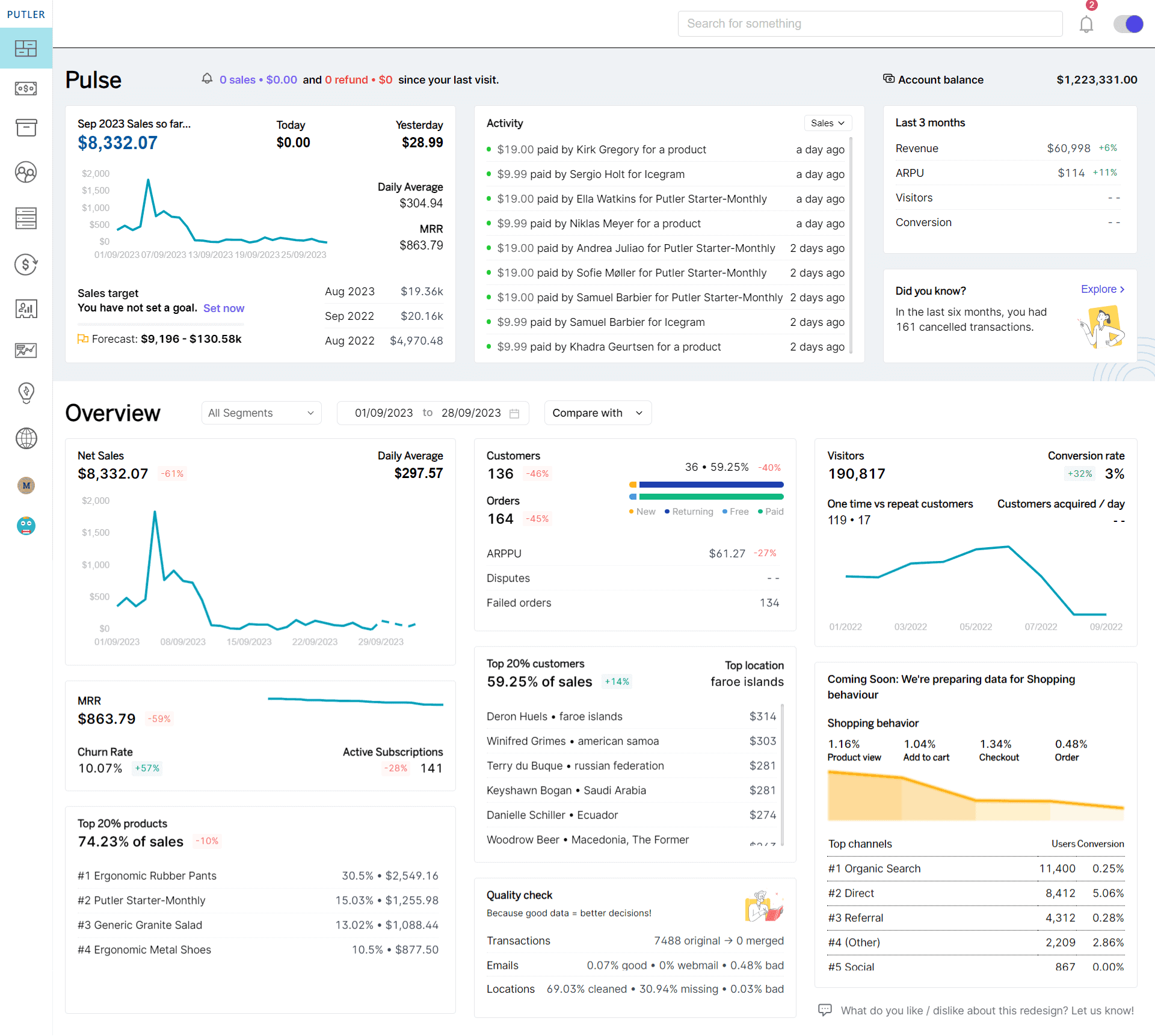
Managing your online store becomes super easy with Putler’s all-in-one dashboard.
Think of it as your control center. Here you can quickly see all the important data regarding your business and make informed decisions based on it, seamlessly.
Plus, Putler comes with dedicated dashboards for products, customers, sales, transactions, web analytics, and more.
Reports On Demand
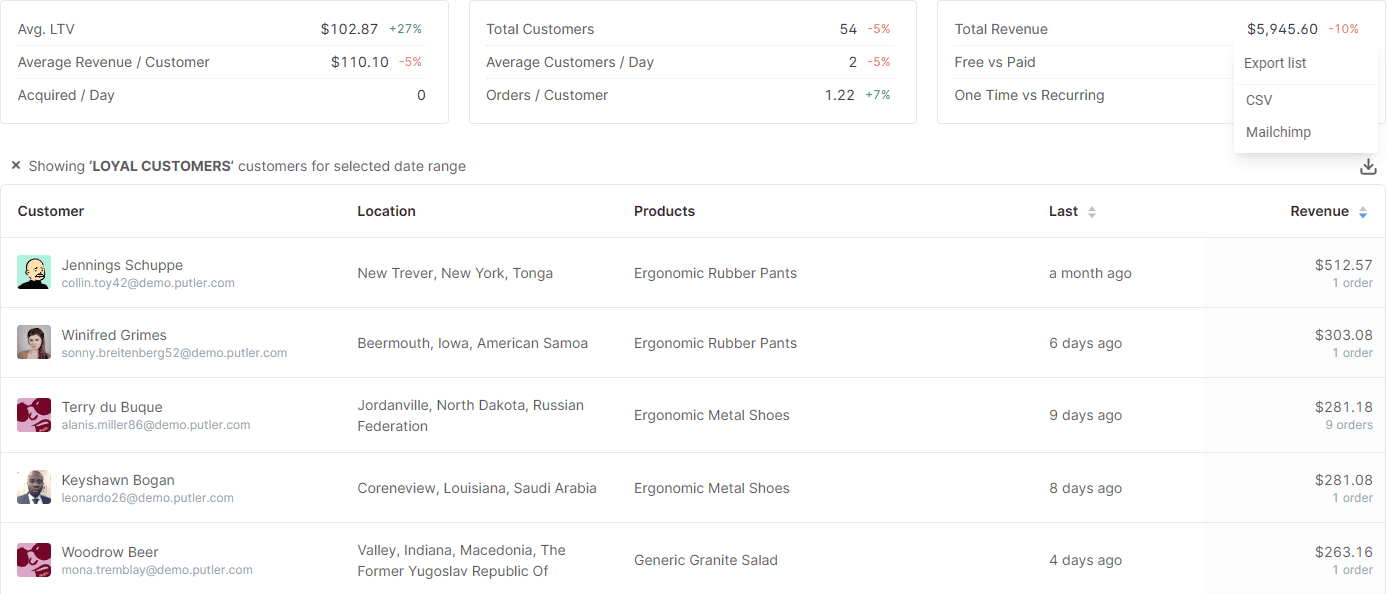
Putler makes it easy for eCommerce sellers to quickly access important reports for their online store.
With one click you can easily download your desired reports from Putler. You can also set up preferred parameters and get super-customized CSV reports.
Also, when it comes to exporting a customer segment for your email marketing campaign, you can send the list to MailChimp or Icegram Express directly from Putler.
Easy Multi-Store Management

If you have multiple eCommerce stores, be it Shopify or Amazon, it’s a challenge to consolidate all the data. Plus, different platforms have different analytics that can be complex and cause confusion.
With Putler you no longer need to jump between different dashboards, and struggle to keep track of your sales, order, or customers.
It lets you you can centralize your data and seamlessly integrate all your stores into one unified platform. Moreover, you can also switch to individual stores for a more focused approach.
Instant Refunds
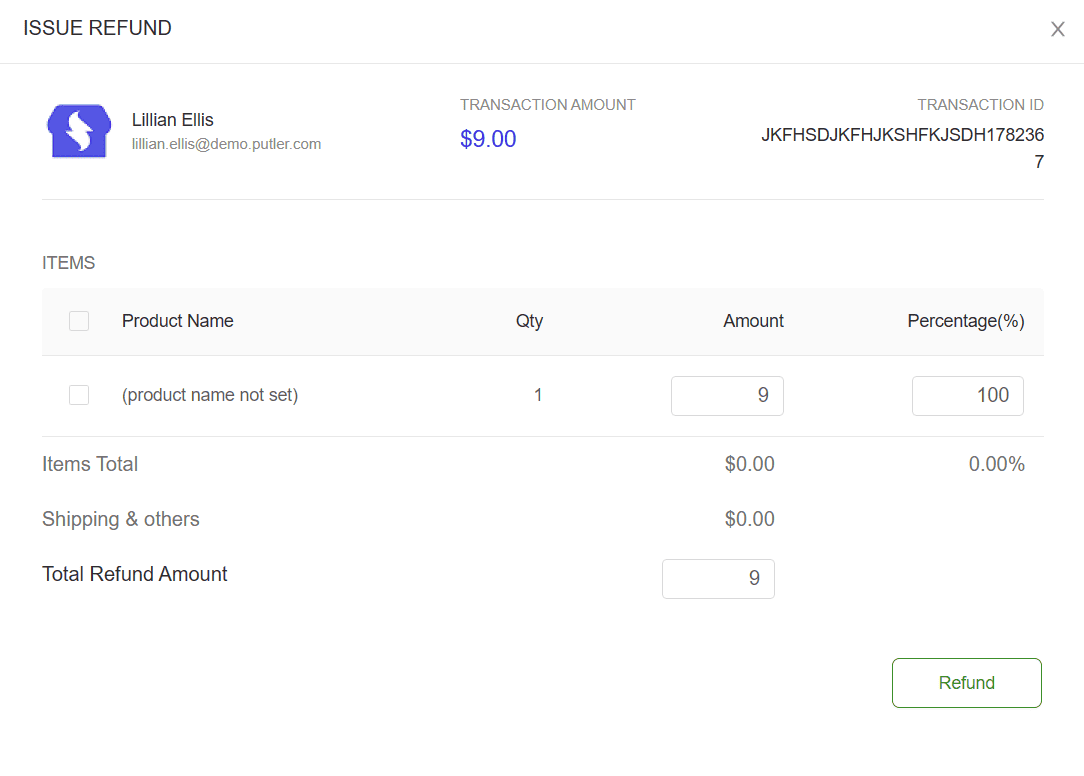
Dealing with refunds can be a hassle, but ensuring customers get their money back promptly and without any inconvenience is crucial.
With Putler, you can easily identify refund seeking customers from Stripe, PayPal, or any other payment sources and process refunds securely in just two simple steps.
This not only saves you time and hassle, but also ensures a smoother return process and keep your customers happy with Putler.
36+ Currency Support
Selling worldwide presents challenges, particularly when managing different currencies.
But with Putler, things are different.
Yes, Putler allows you to accept payments in over 36 currencies, including USD, EUR, GBP, AUD, CAD, Yen, and more.
So, regardless of where your customers make payments from, this tool automatically converts them to your preferred currency.
Undoubtedly, it’s the perfect tool for anyone looking to streamline their international business operations.
RFM Segmentation
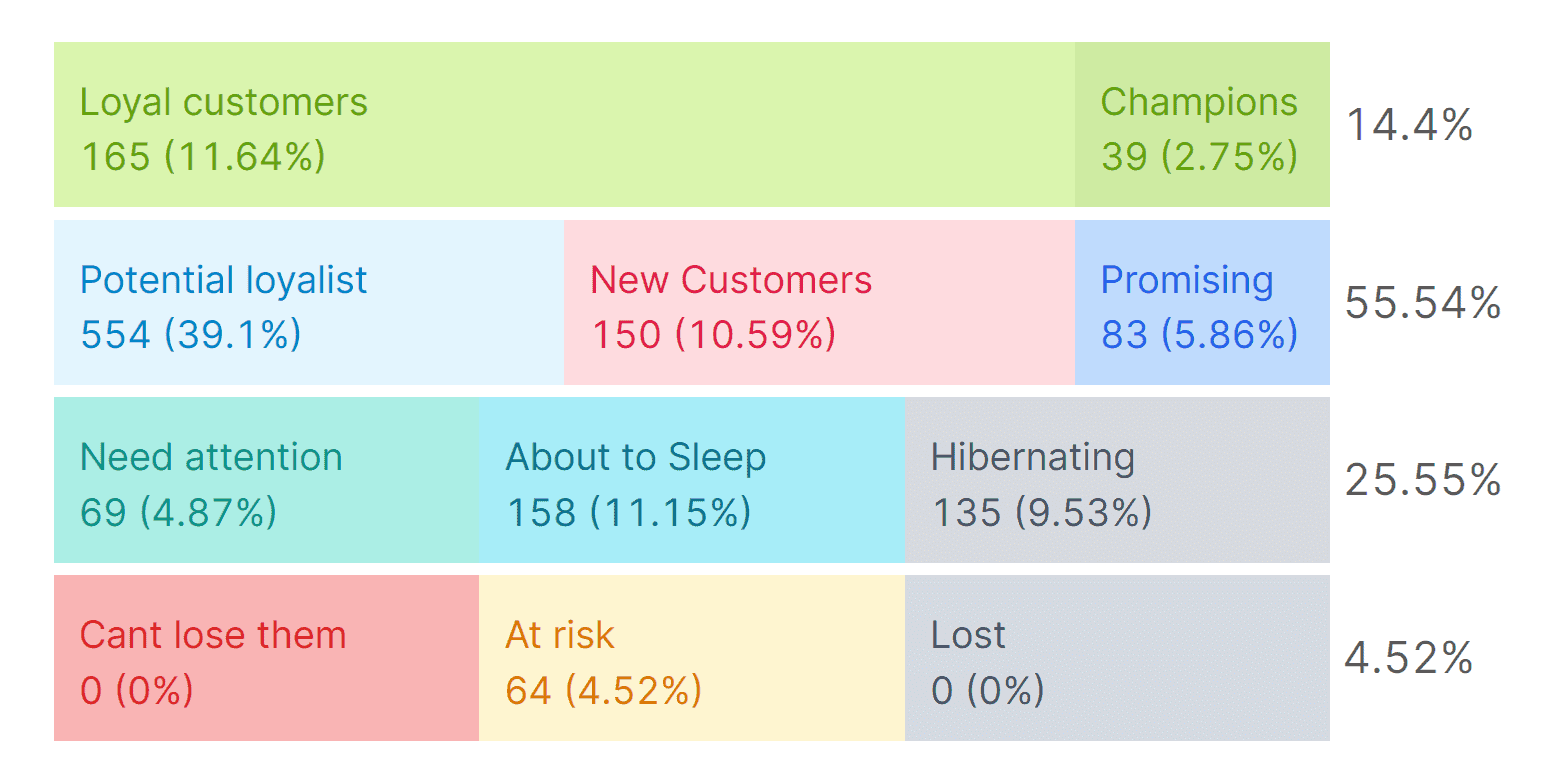
Recency, Frequency, and Monetary segmentation help you quickly identify customer segments. You can leverage these customer segments for more conversions.
Send targeted emails based on customer behavior – upsell and cross-sell to champions, welcome new customers, and retarget customers at risk.
Sales Heatmap
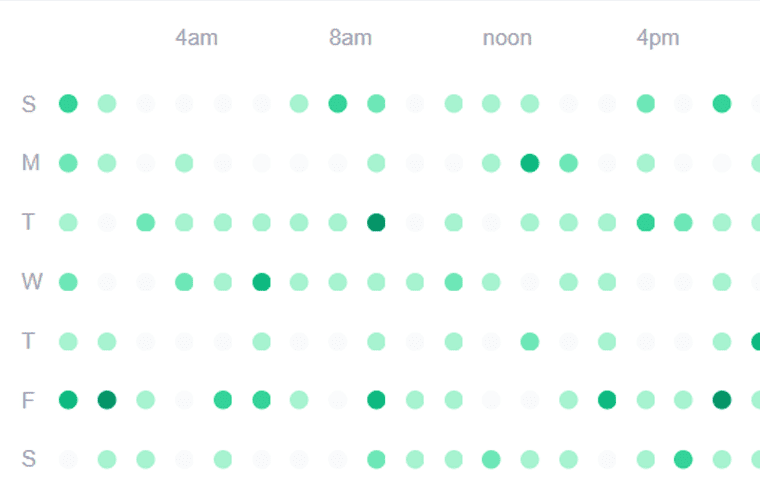
With a sales heat map, you can quickly identify when your customers are most active.
For example, if they are most active at noon on Sundays, you can tailor your marketing strategy to send emails and show discount pop-ups during the peak times.
Doing so can help you increase your conversions and drive more sales.
How Putler Enhances Reporting for Shopify
Shopify’s basic plan lacks advanced reporting features, including customer, order, and transactional reports. Product reports and exports are also limited.
To access these essential features, users are typically required to upgrade to a $300 advanced plan.
However, Putler offers an extensive array of reporting capabilities and more for just $20.
But that’s not all.
In addition to addressing the deficiencies of Shopify’s basic plan, Putler provides advanced filtering and RFM segmentation tools.
These features empower users to identify high-paying customers and those at risk of churn.
Moreover, while Shopify lacks SaaS metrics for deeper insights, Putler provides this capability.
And you can also track multiple stores simultaneously. So, that’s a bonus.
How Putler Enhances Reporting for Amazon
Fulfillment by Amazon (FBA) and Merchant Fulfilled Network (MFN) sellers face unequal report access on Amazon.
But, with Putler, things are different.
Putler analyzes all Amazon transactions, offering thorough reports and insights to help sellers effectively monitor and grow their businesses.
Also, Amazon lacks crucial features including customer and product reports, intuitive filters, and multi-account reporting.
These are essential when it comes to effective e-commerce management.
Moreover, capabilities like RFM customer segmentation, forecasting, performance comparison, and growth insights are absent.
Putler fills these gaps, empowering sellers to optimize their businesses comprehensively.
Conclusion
Deciding between selling on Amazon vs Shopify for your online store is like choosing between controlling your ship or riding the wave of a giant ocean.
Both have their perks, but which suits your needs best? Consider factors like control, fees, and branding to make an informed decision.
But, irrespective of the platform you choose, Putler can enhance your reporting capabilities and streamline your operations.
So, choose the platform that sets your business on course for success.
FAQs
What is the difference between Shopify and Amazon?
Both platforms, be it Shopify or Amazon, are like different types of stores in a big mall. Shopify gives you your shop where you can design everything the way you want.
It’s similar to having your store in a busy shopping street. On the other hand, Amazon is like a huge marketplace where lots of sellers come together to sell their products.
Can I sell the same product on Amazon and Shopify?
Yes, you can sell the same product on both Amazon and Shopify. It’s like having your product in different stores.
But remember, each platform has its own rules and fees. Also, think about how you want to present your product.
On Shopify, you can make it unique to your brand, while on Amazon, it’s listed alongside many other similar products.
Is Amazon or Shopify better?
The answer to Amazon vs Shopify depends on what you’re looking for. If you want more control over your store and brand, Shopify might be better. It’s like having your shop where you set the rules.
But if you prefer the convenience of a big marketplace with lots of customers already there, then Amazon might suit you better.
Think about what’s important for your business—control, customization, reach, and convenience.
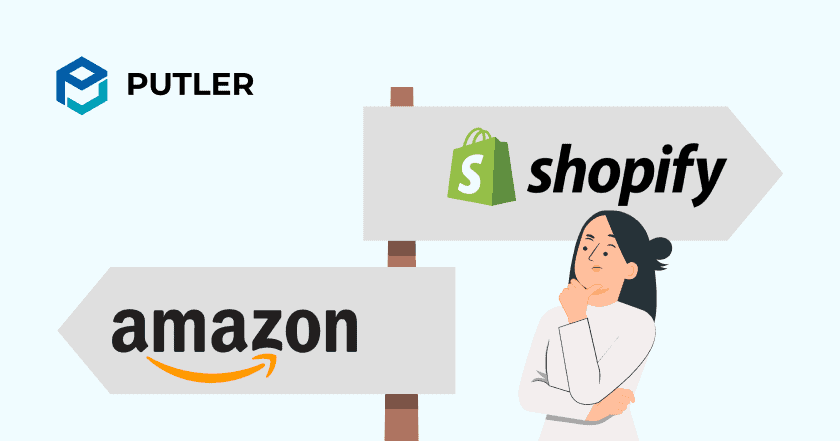
Choosing between Shopify and Amazon FBA depends on your business goals. Shopify offers complete control over your brand and customer experience, while Amazon FBA provides access to a vast customer base and handles logistics. Both have their advantages, so consider your priorities and resources.